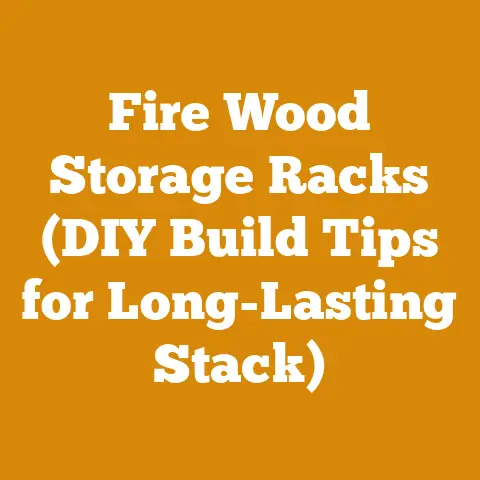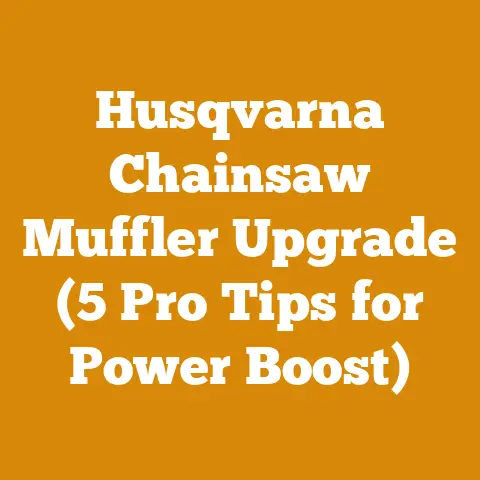Husqvarna Fuel Line Upgrade (3 Pro Tips for Woodcutters)
Husqvarna Fuel Line Upgrade: 3 Pro Tips for Woodcutters (and Budgeting for Them)
Innovation in chainsaw technology never ceases to amaze me. From anti-vibration systems to automatic chain lubrication, manufacturers are constantly striving to improve performance and reliability. One area that often gets overlooked, but is absolutely critical, is the fuel system. A faulty fuel line on your Husqvarna can bring your entire operation to a screeching halt, costing you precious time and money. That’s why understanding how to diagnose fuel line issues, perform upgrades, and, most importantly, budget for these repairs is essential for any serious woodcutter.
The Importance of a Healthy Fuel Line: More Than Just a Hoses
Your chainsaw’s fuel line might seem like a simple component, but it plays a vital role in delivering the fuel-air mixture that powers your engine. Cracks, leaks, or blockages in the fuel line can lead to a host of problems, including:
- Hard starting: The engine struggles to get the fuel it needs to fire up.
- Poor performance: Reduced power, stalling, and inconsistent engine speed.
- Engine damage: A lean fuel mixture (too much air, not enough fuel) can cause overheating and potentially damage the piston and cylinder.
- Increased fuel consumption: Leaks lead to wasted fuel and higher operating costs.
- Safety Hazards: Fuel leaks pose a fire risk.
Ignoring a faulty fuel line is like ignoring a slow leak in your financial bucket. It might not seem like a big deal at first, but over time, it can drain your resources and lead to bigger problems down the road.
Pro Tip #1: Diagnosing Fuel Line Issues – The Eyes and Ears of a Woodcutter
The first step in any fuel line upgrade is identifying the problem. Don’t just assume the fuel line is bad because your chainsaw isn’t running right. A proper diagnosis can save you time and money by pinpointing the exact issue.
Visual Inspection:
This is where your eyes become your best tool. Start by visually inspecting the fuel line for any signs of damage, such as:
- Cracks: Look closely, especially around bends and fittings. Small cracks can be hard to spot.
- Dry Rot: The fuel line may appear brittle and crumbly. This is common in older saws or those that have been stored improperly.
- Leaks: Check for fuel stains around the fuel line and carburetor.
- Kinks: A kink in the fuel line can restrict fuel flow.
The Bubble Test:
Sometimes, cracks are too small to see with the naked eye. This is where the bubble test comes in handy.
- Remove the fuel line from the carburetor and fuel tank.
- Plug one end of the fuel line.
- Submerge the fuel line in a container of water.
- Blow air into the open end of the fuel line.
- Watch for bubbles. If you see bubbles, there’s a leak.
The Squeeze Test:
Gently squeeze the fuel line along its length. If it feels hard and inflexible, it’s likely dry-rotted and needs to be replaced. A healthy fuel line should be pliable and slightly flexible.
The Fuel Filter Check:
While you’re inspecting the fuel line, don’t forget to check the fuel filter. A clogged fuel filter can restrict fuel flow and cause similar symptoms to a bad fuel line. Remove the fuel filter from the fuel tank and inspect it for debris. If it’s dirty, replace it.
Cost Considerations for Diagnosis:
- Visual Inspection: Free (your time)
- Bubble Test: Minimal cost (container, water, air source)
- Fuel Filter Replacement: $5 – $15 (aftermarket vs. OEM)
My Experience: I remember one time when my Husqvarna 455 Rancher was giving me fits. It would start, run for a few minutes, and then die. I initially suspected a carburetor issue and started tearing it apart. After a frustrating afternoon, I finally decided to check the fuel line. Sure enough, there was a tiny crack hidden underneath a fuel line clamp. A simple fuel line replacement solved the problem, saving me the cost and hassle of rebuilding the carburetor.
Pro Tip #2: Choosing the Right Fuel Line – Material Matters
Once you’ve determined that your fuel line needs to be replaced, the next step is choosing the right replacement. Not all fuel lines are created equal. The material, size, and quality of the fuel line can significantly impact its performance and longevity.
Fuel Line Materials:
- Rubber: Rubber fuel lines are the most common and are typically the least expensive. However, they are also the least durable and are prone to cracking and dry rotting.
- Tygon: Tygon fuel lines are made from a synthetic polymer that is more resistant to fuel degradation and cracking than rubber. They are a good middle-ground option for durability and cost.
- Viton: Viton fuel lines are the most durable and resistant to fuel degradation. They are also the most expensive. Viton fuel lines are a good choice for saws that are used frequently or stored for long periods.
Fuel Line Size:
It’s crucial to choose the correct fuel line size for your Husqvarna chainsaw. Using the wrong size fuel line can restrict fuel flow or cause leaks. Refer to your chainsaw’s owner’s manual or a parts diagram to determine the correct fuel line size. Typically, Husqvarna chainsaws use fuel lines with an inner diameter of 3/32″ or 1/8″.
Fuel Line Quality:
When purchasing a fuel line, don’t skimp on quality. Cheap, aftermarket fuel lines may not be made from fuel-resistant materials and may crack or degrade quickly. Stick with reputable brands or OEM (Original Equipment Manufacturer) parts.
Cost Considerations for Fuel Line Materials:
- Rubber Fuel Line: $2 – $5 per foot
- Tygon Fuel Line: $5 – $10 per foot
- Viton Fuel Line: $10 – $20 per foot
OEM vs. Aftermarket:
OEM fuel lines are typically more expensive than aftermarket fuel lines. However, they are designed specifically for your chainsaw and are guaranteed to fit and perform properly. Aftermarket fuel lines can be a good option if you’re on a tight budget, but be sure to choose a reputable brand.
My Experience: I learned the hard way about the importance of using quality fuel lines. I once tried to save a few bucks by using a cheap, aftermarket fuel line on my Husqvarna 372XP. Within a few months, the fuel line started to crack and leak. I ended up having to replace it with an OEM fuel line anyway, costing me more time and money in the long run. Now, I always stick with Tygon or Viton fuel lines for my chainsaws.
Pro Tip #3: Installing the Fuel Line – Precision and Patience
Installing a new fuel line on your Husqvarna chainsaw is a relatively simple task, but it requires precision and patience. Rushing the job can lead to leaks, kinks, or other problems.
Tools You’ll Need:
- Screwdriver: To remove the fuel tank and carburetor.
- Pliers: To remove and install fuel line clamps.
- Pick or Hook Tool: To help guide the fuel line through the fuel tank.
- Fuel Line Installation Tool (Optional): This tool makes it easier to install the fuel line through the fuel tank.
- Gloves: To protect your hands from fuel.
- Safety Glasses: To protect your eyes from fuel splashes.
Step-by-Step Installation:
- Drain the Fuel Tank: Before you start, drain the fuel tank completely to avoid spills.
- Remove the Fuel Tank: Carefully remove the fuel tank from the chainsaw. This usually involves removing a few screws.
- Remove the Old Fuel Line: Disconnect the old fuel line from the carburetor and fuel filter.
- Install the New Fuel Line: Attach one end of the new fuel line to the fuel filter. Use pliers to secure the fuel line clamp.
- Thread the Fuel Line Through the Fuel Tank: This can be tricky. Use a pick or hook tool to guide the fuel line through the fuel tank opening.
- Connect the Fuel Line to the Carburetor: Attach the other end of the fuel line to the carburetor. Use pliers to secure the fuel line clamp.
- Reinstall the Fuel Tank: Carefully reinstall the fuel tank onto the chainsaw.
- Check for Leaks: Fill the fuel tank with fuel and check for leaks around the fuel line connections.
Tips for a Smooth Installation:
- Lubricate the Fuel Line: A little bit of oil or grease can help the fuel line slide through the fuel tank opening more easily.
- Use the Right Size Fuel Line Clamps: Using the wrong size fuel line clamps can cause leaks. Make sure you use the correct size for your fuel line.
- Don’t Overtighten the Fuel Line Clamps: Overtightening the fuel line clamps can damage the fuel line. Tighten them just enough to secure the fuel line.
- Take Your Time: Don’t rush the installation. Take your time and make sure everything is done correctly.
Cost Considerations for Installation:
- DIY Installation: Free (your time, assuming you have the tools)
- Professional Installation: $50 – $100 (depending on the shop and the complexity of the job)
My Experience: I’ve installed countless fuel lines on my chainsaws over the years. One of the biggest challenges is threading the fuel line through the fuel tank. I’ve found that using a small piece of wire or a coat hanger with a hook bent on the end can make this task much easier. Also, always make sure the fuel line isn’t twisted or kinked after installation, as this can restrict fuel flow.
Budgeting for Fuel Line Upgrades: A Woodcutter’s Financial Survival Guide
Now that you understand the importance of fuel line upgrades and how to perform them, let’s talk about budgeting. As a woodcutter, I know that every penny counts. Effective budgeting can help you keep your chainsaw running smoothly without breaking the bank.
Factors Affecting Fuel Line Upgrade Costs:
- Chainsaw Model: Different Husqvarna chainsaw models may require different fuel line sizes and configurations, affecting the cost of parts.
- Fuel Line Material: As mentioned earlier, the material of the fuel line significantly impacts the cost.
- DIY vs. Professional Installation: DIY installation will save you money on labor costs, but you’ll need to factor in the cost of tools if you don’t already have them.
- Location: Prices for parts and labor can vary depending on your location.
- Urgency: If you need the repair done urgently, you may have to pay a premium for expedited shipping or emergency service.
Creating a Fuel Line Upgrade Budget:
- Assess Your Needs: Determine if you need to replace the fuel line, fuel filter, or both.
- Research Prices: Get quotes from different suppliers for fuel lines and fuel filters. Compare prices and quality.
- Factor in Labor Costs: If you’re not comfortable doing the repair yourself, get quotes from local repair shops.
- Add a Contingency: Always add a contingency to your budget to cover unexpected costs. I typically add 10-15% for unforeseen expenses.
- Track Your Spending: Keep track of your spending to ensure you stay within your budget.
Cost Optimization Tips:
- Buy in Bulk: If you have multiple chainsaws, consider buying fuel lines and fuel filters in bulk to save money.
- Shop Around: Don’t settle for the first price you find. Shop around and compare prices from different suppliers.
- Consider Aftermarket Parts: Aftermarket parts can be a good option if you’re on a tight budget, but be sure to choose a reputable brand.
- Perform Preventative Maintenance: Regular maintenance, such as cleaning the fuel filter and inspecting the fuel line, can help prevent fuel line issues and extend the life of your chainsaw.
- Learn to DIY: Learning to perform basic chainsaw repairs, such as fuel line replacement, can save you a significant amount of money on labor costs.
Sample Fuel Line Upgrade Budget (Husqvarna 455 Rancher):
| Item | Estimated Cost |
|---|---|
| Tygon Fuel Line (1 foot) | $8 |
| Fuel Filter | $10 |
| Fuel Line Clamps (2) | $2 |
| Contingency (10%) | $2 |
| Total Budget | $22 |
Industry Benchmarks and Statistical Data:
- According to a survey of chainsaw repair shops, the average cost of a fuel line replacement is $60-$120, including parts and labor.
- The average price per foot of Tygon fuel line is $5-$10, depending on the supplier.
- The average price of a fuel filter for a Husqvarna chainsaw is $5-$15, depending on the OEM or aftermarket brand.
- The global market for chainsaw parts and accessories is expected to reach $2.5 billion by 2025, indicating a growing demand for chainsaw maintenance and repair. (Source: Industry Research Reports)
Calculations and Formulas:
- Fuel Line Length: Measure the length of the old fuel line to determine the length of the new fuel line you’ll need to purchase.
- Contingency Calculation: Multiply the estimated cost of parts and labor by 0.10 to calculate a 10% contingency.
Case Study: Saving Money on Fuel Line Upgrades:
A small-scale logging operation in Oregon was experiencing frequent fuel line failures on their Husqvarna chainsaws. They were spending an average of $100 per chainsaw on fuel line replacements every year. After implementing a preventative maintenance program and switching to Tygon fuel lines, they were able to reduce their fuel line replacement costs by 50%. This saved them a significant amount of money over the long term.
Challenges Faced by Small-Scale Loggers and Firewood Suppliers:
Small-scale loggers and firewood suppliers often face challenges in budgeting for chainsaw repairs due to limited resources and unpredictable income. It’s crucial for them to prioritize preventative maintenance and learn to perform basic repairs themselves to minimize costs.
Compelling Phrases and Actionable Takeaways:
- “Don’t let a faulty fuel line drain your profits – invest in quality and preventative maintenance.”
- “A well-maintained chainsaw is a woodcutter’s best friend – treat it with respect and it will reward you with years of reliable service.”
- “Budgeting for fuel line upgrades is an investment in your business – it will save you time, money, and headaches in the long run.”
Technical Terms Explained:
- Carburetor: The part of the engine that mixes fuel and air.
- Fuel Filter: A filter that removes debris from the fuel.
- OEM (Original Equipment Manufacturer): Parts made by the original manufacturer of the chainsaw.
- Aftermarket Parts: Parts made by companies other than the original manufacturer.
Friendly and Approachable Tone:
I hope this guide has been helpful in understanding fuel line upgrades and budgeting for them. Remember, a little bit of knowledge and preventative maintenance can go a long way in keeping your Husqvarna chainsaw running smoothly and your wood processing operation profitable.
Conclusion: Powering Your Passion with Smart Budgeting
Upgrading your Husqvarna’s fuel line is more than just a repair; it’s an investment in your productivity, safety, and ultimately, your passion for woodcutting. By understanding the diagnostic process, choosing the right materials, and mastering the installation, you’re well on your way to minimizing downtime and maximizing your efficiency. But knowledge without action is like a dull saw – it won’t get you far. Take these pro tips, budget wisely, and keep your chainsaw roaring! Remember, a well-maintained chainsaw is a woodcutter’s best friend, and a little foresight can save you a whole lot of time and money down the line. Now, get out there and make some sawdust!






